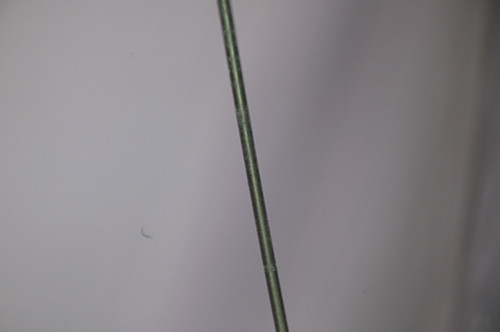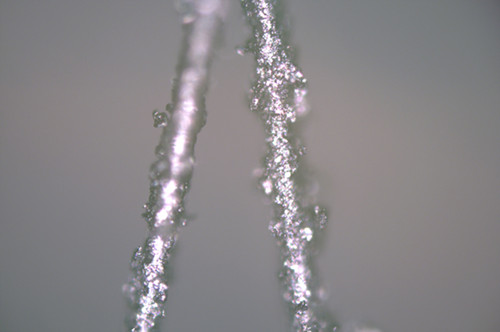A Modification Method of Polyvinyl Alcohol Fiber for Strain Hardening Cementitious Composite
A technology of polyvinyl alcohol fiber and composite material, which is applied in the field of epoxy resin-nanographite coating surface modification of polyvinyl alcohol fiber, can solve the problem of reducing fiber performance, easy peeling off of oil film coating, damage to the surface of polyvinyl alcohol fiber, etc. problems, to achieve the effect of reducing the interfacial friction force, good strain hardening performance, and strong bonding performance
- Summary
- Abstract
- Description
- Claims
- Application Information
AI Technical Summary
Problems solved by technology
Method used
Image
Examples
Embodiment 1
[0025] 1) Prepare epoxy resin pretreatment solution;
[0026] Prepare diluted epoxy resin pretreatment solution, the epoxy resin diluent is alcohol, and the mass fraction of epoxy resin is 5%.
[0027] 2) Polyvinyl alcohol fibers soaked in epoxy resin pretreatment solution;
[0028] Soak the untreated polyvinyl alcohol fiber in the epoxy resin pretreatment solution, the soaking temperature is 50°C, and the soaking time is 3h.
[0029] 3) Dry the polyvinyl alcohol fiber after pretreatment;
[0030] The polyvinyl alcohol fibers soaked in the epoxy resin pretreatment solution were taken out, and vacuum-dried in a vacuum drying oven to constant weight at a drying temperature of 50°C.
[0031] 4) The surface of polyvinyl alcohol fiber is coated with nano-graphite
[0032] The dried polyvinyl alcohol fiber and nano-graphite were mechanically stirred and mixed, and an electric stirrer was used for stirring and mixing, the stirring rate was 3000 rpm, and the mechanical stirring and...
Embodiment 2
[0035] 1) Prepare epoxy resin pretreatment solution;
[0036] Prepare a diluted epoxy resin pretreatment solution, the epoxy resin diluent is acetone, and the mass fraction of epoxy resin is 2%.
[0037] 2) Polyvinyl alcohol fibers soaked in epoxy resin pretreatment solution;
[0038] Soak the untreated polyvinyl alcohol fibers in the epoxy resin pretreatment solution, the soaking temperature is 60°C, and the soaking time is 2h.
[0039] 3) Dry the polyvinyl alcohol fiber after pretreatment;
[0040] The polyvinyl alcohol fibers soaked in the epoxy resin pretreatment solution were taken out, and vacuum-dried in a vacuum drying oven to constant weight at a drying temperature of 60°C.
[0041] 4) The surface of polyvinyl alcohol fiber is coated with hydrophobic nano-graphite
[0042] The dried polyvinyl alcohol fiber and nano-graphite were mechanically stirred and mixed, and an electric stirrer was used for stirring and mixing, the stirring rate was 2000 rpm, and the mechanic...
Embodiment 3
[0045] 1) Prepare epoxy resin pretreatment solution;
[0046] Prepare diluted epoxy resin pretreatment solution, the epoxy resin diluent is alcohol, and the mass fraction of epoxy resin is 6%.
[0047] 2) Polyvinyl alcohol fibers soaked in epoxy resin pretreatment solution;
[0048] Soak the untreated polyvinyl alcohol fiber in the epoxy resin pretreatment solution, the soaking temperature is 60°C, and the soaking time is 3h.
[0049] 3) Dry the polyvinyl alcohol fiber after pretreatment;
[0050] The polyvinyl alcohol fibers soaked in the epoxy resin pretreatment solution were taken out, and vacuum-dried in a vacuum drying oven to constant weight at a drying temperature of 60°C.
[0051] 4) The surface of polyvinyl alcohol fiber is coated with hydrophobic nano-graphite
[0052] The dried polyvinyl alcohol fiber and nano-graphite were mechanically stirred and mixed, and an electric stirrer was used for stirring and mixing, the stirring rate was 1000 rpm, and the mechanical ...
PUM
| Property | Measurement | Unit |
|---|---|---|
| quality score | aaaaa | aaaaa |
| quality score | aaaaa | aaaaa |
| quality score | aaaaa | aaaaa |
Abstract
Description
Claims
Application Information
 Login to View More
Login to View More - R&D
- Intellectual Property
- Life Sciences
- Materials
- Tech Scout
- Unparalleled Data Quality
- Higher Quality Content
- 60% Fewer Hallucinations
Browse by: Latest US Patents, China's latest patents, Technical Efficacy Thesaurus, Application Domain, Technology Topic, Popular Technical Reports.
© 2025 PatSnap. All rights reserved.Legal|Privacy policy|Modern Slavery Act Transparency Statement|Sitemap|About US| Contact US: help@patsnap.com



